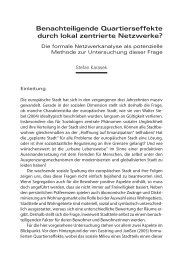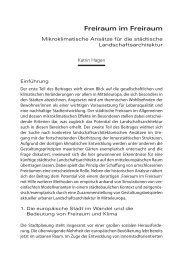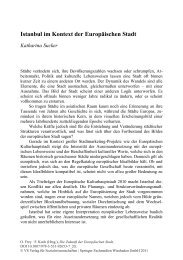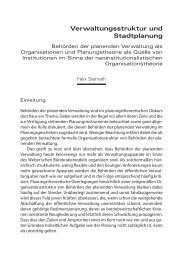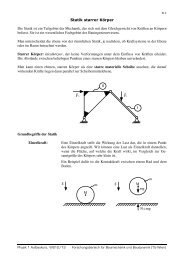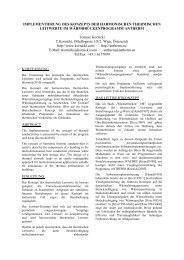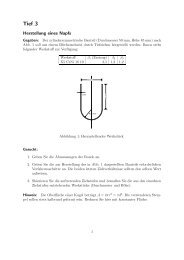Spectral characteristics of ultrashort pulses in Kerr-lens - TU Wien
Spectral characteristics of ultrashort pulses in Kerr-lens - TU Wien
Spectral characteristics of ultrashort pulses in Kerr-lens - TU Wien
Create successful ePaper yourself
Turn your PDF publications into a flip-book with our unique Google optimized e-Paper software.
rLe <strong>in</strong> Fig. 7 Px104 ti,, fs E, nJ<br />
solid 3.2 27 20<br />
dash 2 30 12<br />
dot 3 25 16<br />
Table 2. Normalized pump power, pulse duration and energy for Fig. 7<br />
Table 3. Ultrashort pulse energies and durations for Fig. 8<br />
Po<strong>in</strong>ts A B C D E F C H I J K<br />
Energy, nJ 16 27 47 54 20 38 52 119 33 78 103<br />
Pulse width, fs 45 28 20 23 28 20 18 37 25 14 19<br />
case) there is no Stokes frequency shift, contradict<strong>in</strong>g the experimental data. Moreover, the maximal shift (<strong>of</strong> about<br />
6 nm) is by an order <strong>of</strong> magnitude less than that observed <strong>in</strong> the experiment. It is clear, that ga<strong>in</strong> band asymmetry<br />
and output loss alone cannot produce large self-frequency shift <strong>in</strong> Cr:LiSGaF laser.<br />
Stronger contribution is provided by the reabsorption <strong>in</strong> the active medium (curve EFGH on Fig. 8). For small<br />
energies the simulation result (po<strong>in</strong>t E on Fig. 8) co<strong>in</strong>cides with the prediction made on the basis <strong>of</strong> elementary<br />
model <strong>of</strong> net-ga<strong>in</strong> maximum shift (solid curve). The rise <strong>of</strong> the pulse energy <strong>in</strong>creases the shift (up to 25 nm <strong>in</strong> our<br />
case), much more than <strong>in</strong> the previous case, although still by a factor <strong>of</strong> two less than <strong>in</strong> the experiment.<br />
Note, that after certa<strong>in</strong> pulse energy the spectral shift is aga<strong>in</strong> decreas<strong>in</strong>g. This is caused by the <strong>in</strong>crease <strong>of</strong> the<br />
pulse duration for the large energies (po<strong>in</strong>t H on Fig. 8), due to the nonl<strong>in</strong>ear loss saturation, result<strong>in</strong>g <strong>in</strong> reduced<br />
spectrum width. The laser approaches the condition <strong>of</strong> the cw operation, described by solid curve (although the<br />
conditions <strong>of</strong> pulsed ga<strong>in</strong> saturation strongly differ from those <strong>in</strong> cw-regime).<br />
4.3. Raman scatter<strong>in</strong>g<br />
As po<strong>in</strong>ted out <strong>in</strong> the previous section, the net-ga<strong>in</strong> shift model fails to provide correct description <strong>of</strong> the experimental<br />
data by a factor <strong>of</strong> two. However, tak<strong>in</strong>g the stimulated Raman scatter<strong>in</strong>g <strong>in</strong>to account allows to obta<strong>in</strong> large<br />
frequency shifts, <strong>in</strong>creas<strong>in</strong>g with pulse energy growth. In Fig. 8 the curve IJK demonstrates the Raman scatter<strong>in</strong>g<br />
action <strong>in</strong> the absence <strong>of</strong> reabsorption effect. As the simulation demonstrates, the red components orig<strong>in</strong>ate from the<br />
amplified Raman signal, which pulls the whole spectrum over the long wavelength limit at the given pump power,<br />
def<strong>in</strong>ed by the spectral filter<strong>in</strong>g.<br />
Note the pronounced threshold-like character <strong>of</strong> the effect. For the small energies (po<strong>in</strong>t I) the spectral shift is<br />
negligible, but the energy growth causes very strong shift (60 nm <strong>in</strong> our case) <strong>in</strong> good agreement with experimental<br />
results 1,3,4 and with analytical prediction 8 S<strong>in</strong>ce the ga<strong>in</strong> saturation does not play important role <strong>in</strong> this case,<br />
the dependence <strong>of</strong> frequency shift on ga<strong>in</strong> coefficient is <strong>in</strong>significant.<br />
As already mentioned above, the ma<strong>in</strong> contribution to the stimulated Raman process comes from the energy<br />
transfer from the blue part <strong>of</strong> the pulse spectrum (pump) to the red one (Stokes). The efficiency <strong>of</strong> the stimulated<br />
Raman scatter<strong>in</strong>g is therefore def<strong>in</strong>ed by the product <strong>of</strong> <strong>in</strong>tensities at pump and Stokes frequencies. The separation<br />
between Stokes and pump components is fixed, it is equal to the Raman l<strong>in</strong>e frequency fZ, . Therefore, decreas<strong>in</strong>g<br />
the pulse spectrum width strongly suppresses the effect and reduces self-frequency shift. Assum<strong>in</strong>g that the pulse<br />
spectrum has exponential fall-<strong>of</strong>f to the blue and red sides, we see that the dependence <strong>of</strong> the Raman shift on the<br />
pulse spectrum width should be asymptotically exponential at long pulse durations. This is also the result <strong>of</strong> the<br />
analytical theory <strong>in</strong> Ref,8 where sech2 pulse shape has been assumed.<br />
As the Raman effect strongly depends on the pulse <strong>in</strong>tensity and Raman ga<strong>in</strong>, it should be especially pronounced<br />
<strong>in</strong> low-ga<strong>in</strong> lasers work<strong>in</strong>g with low output coupl<strong>in</strong>g and high <strong>in</strong>tracavity pulse energy, such as Cr:LiSGaF,<br />
Cr:LiSAF, Cr:YAG. These materials also possess strong and broad Raman l<strong>in</strong>es . Large power-dependent red-shift<br />
<strong>in</strong> Cr:LiSGaF and Cr:LiSAF is well documented 13 In femtosecond Cr:YAG lasers, femtosecond pulse spectrum is<br />
also always red-shifted with respect to the cw wavelength <strong>in</strong> the same resonator 14<br />
Proc. SPIE Vol. 4752 23<br />
Downloaded From: http://spiedigitallibrary.org/ on 04/12/2013 Terms <strong>of</strong> Use: http://spiedl.org/terms






